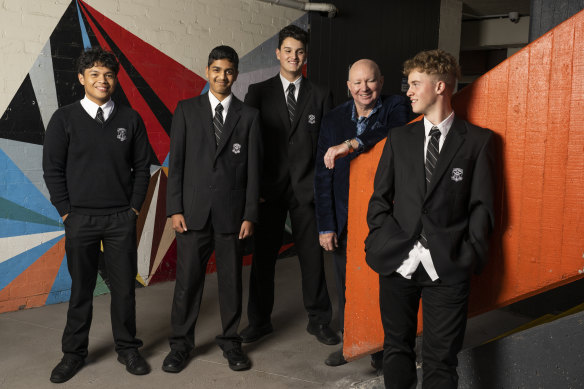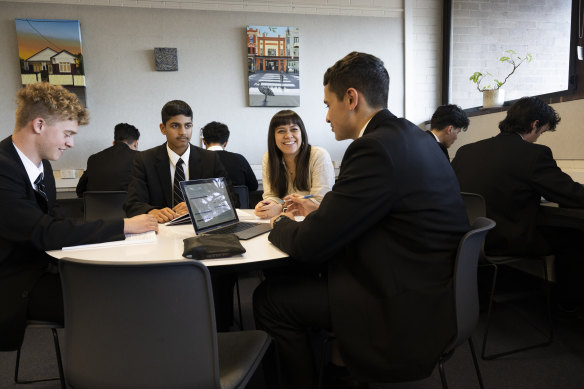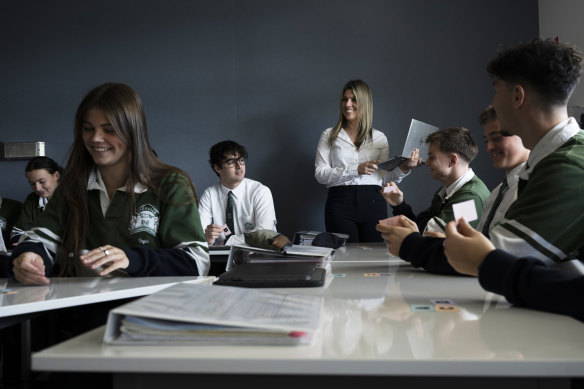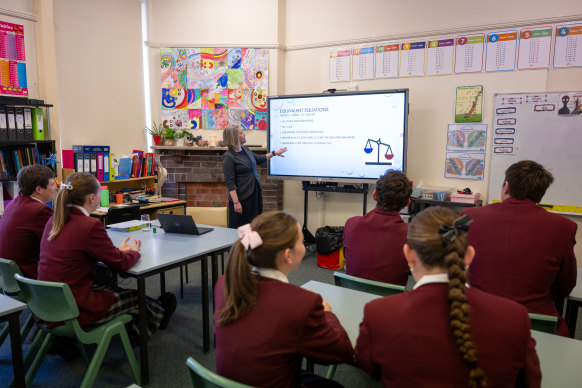By Lucy Carroll and Nigel Gladstone
North Sydney Boys, the Conservatorium High and Baulkham Hills High achieved the highest average scores in the Higher School Certificate, an analysis of results at hundreds of public schools reveals.
Students at the three selective schools recorded an average HSC score above 89 when the mean of all subjects was taken, narrowly eclipsing James Ruse and North Sydney Girls.
A fresh Herald analysis of five years of HSC data also reveals comprehensive schools achieved the biggest gains in averages, with Quirindi High, Ashfield Boys and Moss Vale High recording the most improved results since 2019.
Every December the Herald publishes school league tables based on results that only identify students achieving top band in their final exams – a band 6, or marks over 90. It is a limited metric, and experts have urged the government to publish a richer data set that reflects a fuller range of achievement.
Analysing average HSC scores aims to shed light on the public schools achieving strong – and improving – results across their student cohort.
Willoughby Girls, Cheltenham Girls and Balgowlah Boys were the strongest-performing comprehensives last year, notching up an average of 81 or above across all subjects.
Another single-sex school, Ashfield Boys, was among the most improved, recording significant gains in its combined average over five years. Principal Dwayne Hopwood attributes the upswing to a powerful shift in culture, setting high expectations and a sharp focus on reading skills from year 7.

The principal at Ashfield Boys, Dwayne Hopwood, teaches a weekly year 9 English class and holds seminars for students on metacognition.Credit: Louise Kennerley
“When I started here a decade ago, we began looking at the potential of the students as opposed to what they were achieving at the time,” Hopwood says. With an English advanced average of 86.7 last year, it scored just ahead of Fort Street, Sydney Boys and Normanhurst Boys in that subject.
Hopwood says establishing a senior study centre in 2015 marked a “symbolic shift” in the school’s culture, with teachers creating individualised study plans for all senior students. In year 7, pupils join a structured reading program and compete to win gift cards for reaching targets or hitting 1 million words a year.
“We are now focusing on years 9 and 10. Working on encouraging them to move away from their phones, read more before and after school to help reach a new level of potential,” he says.

Ashfield Boys High senior study teacher Rachel Bennett with year 11 students. Credit: Louise Kennerley
Ashfield Boys English teacher Kate Stitt says creating a positive culture in the classroom is critical because students “can sense your attitude, and they can end up mirroring that behaviour”.
“I also have clear goals and aims for the class. We might concentrate on vocabulary in one lesson, and I will make it clear what I expect students to achieve. Not having that structure can feel very unsettling.”
A similar emphasis on literacy has led Quirindi High, a school of about 330 students south of Tamworth, to lift its English advanced average score to 82.8 last year.
“Not all kids come to us with the same reading ability, so we focus on kids in the junior years who need to catch up,” principal Ian Worley says. The school runs intensive year 7 and 8 literacy lessons and reading intervention programs, intended to squeeze “four years of learning growth into a two-year period”.
Its combined average mark climbed more than eight marks in five years, while its English advanced average is 11 marks ahead of similar schools.
The state’s fully selective schools still top the rankings on an analysis of averages, mirroring the league tables based on top-band results. Willoughby Girls tops comprehensive schools, achieving an average of 82 when the mean of all subjects is taken.
The Herald collected scores from 373 public school annual reports over five years to 2023, which include averages achieved in each subject taken.
Private and Catholic schools are excluded as many do not report their mean scores.
Schools including Moss Vale High, The Rivers Secondary College Kadina High, Glenwood High and Cronulla High achieved among the greatest gains in average scores in the past five years.

Cronulla High School teacher Paris Stasos with year 12 students.Credit: Louise Kennerley
When league tables are based on average marks, Willoughby Girls, Cheltenham Girls, Balgowlah Boys and NBSC Freshwater Senior Campus surge into the top 30.
Cronulla High, which had its average score rise from 72 to 77 in five years, has incorporated fast-paced assessment and knowledge checks to help gauge and track students’ learning.
“We engage the students in quick assessment activities at the start and end of lessons, and are consistently evaluating the students’ understanding and comprehension,” says head teacher of secondary studies Paris Stasos.
“A lot of time is spent on exam techniques, modelling and practice writing under timed HSC-style conditions.”
The schools identified as best improvers recorded the biggest rise in scores over five years while achieving a minimum average of 75 or more as a combined score in all subjects.
Education experts have called for a wider set of measures when reporting HSC results, including median study scores and post-school destinations. Victoria publishes these when reporting on VCE results.
HSC average scores, available in public school annual reports, represent the average of students’ exam mark and school assessment mark. ATARs are not publicly available (although as of last year, individual ATARs are given to schools by the Universities Admissions Centre).

An analysis of HSC average scores shows Quirindi High is among the state’s most improved public schools.Credit: Benham Fisher
While parents can access NAPLAN results via My School to track the reading and maths progress of students at a school from years 3 to 9, similar public data is not available for the HSC.
The NSW Education Department also holds critical value-add information for all schools – which shows the estimated contribution a school makes to student learning – but that data is not publicly available.
The Herald has previously reported that value-add data has provided education officials with inside knowledge about how some schools, like Burwood Girls High, have achieved improved results.
Earlier this year, NSW Education Standards Authority chief executive Paul Martin flagged possible changes to the release of school performance data, but warned against the wholesale publication of league tables. NESA recently began publishing HSC band distributions by students’ location and socioeconomic background.
“It’s not tenable to have no common academic view of student performance … It’s about how and what we produce, and how carefully it’s disseminated,” Martin said.
Check out Campus, our higher education hub, including an interactive course search tool
More from Campus:
- Feeling overwhelmed by uni applications? Here’s what year 12 students need to know
- Where Australia’s universities rank among the world’s best
- Here are five things I learnt from studying in Paris for six months
- Where to start when you don’t know what career you want
Start the day with a summary of the day’s most important and interesting stories, analysis and insights. Sign up for our Morning Edition newsletter.